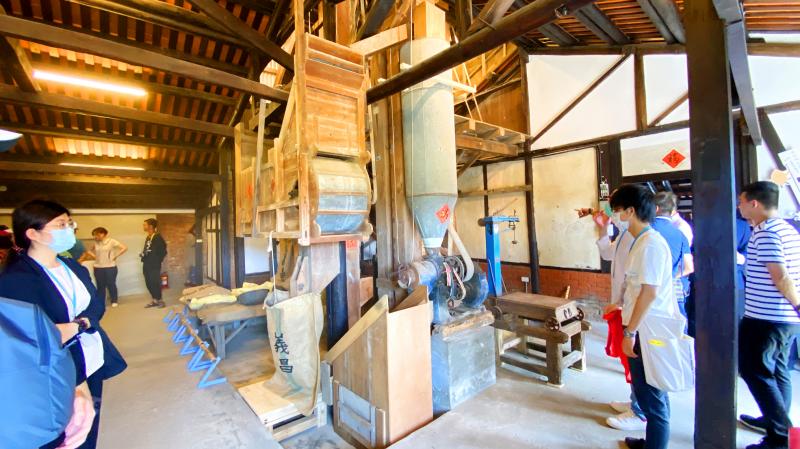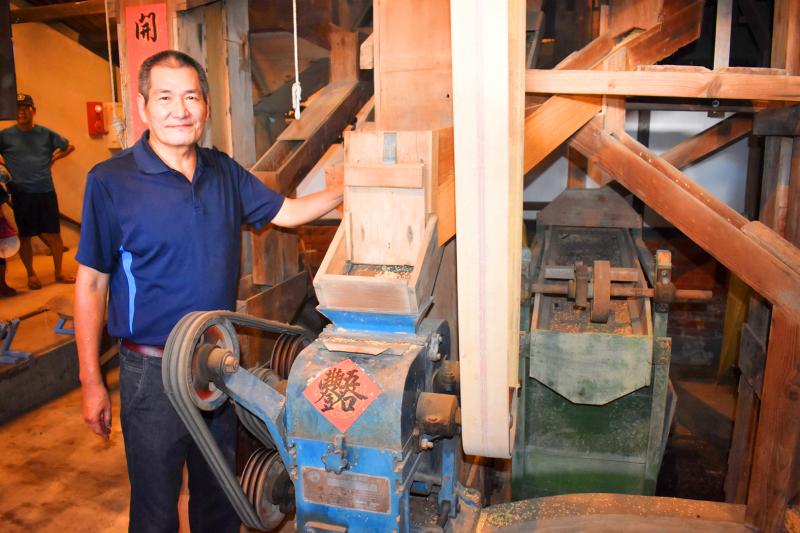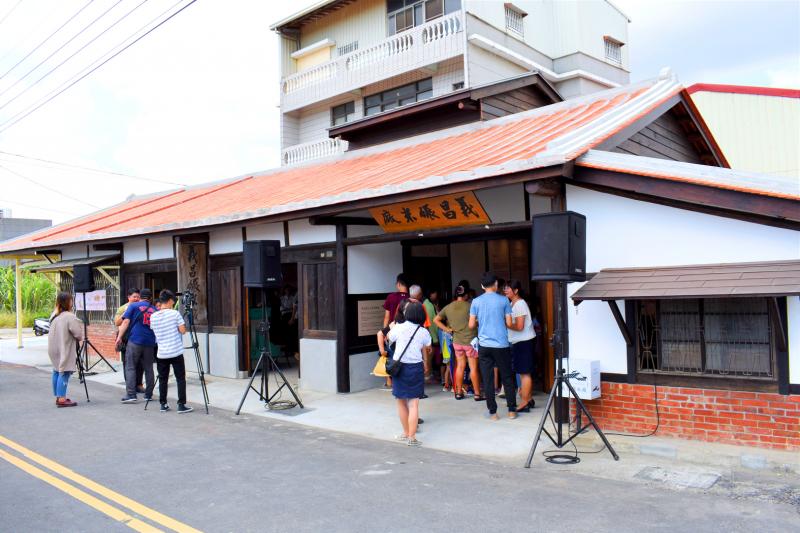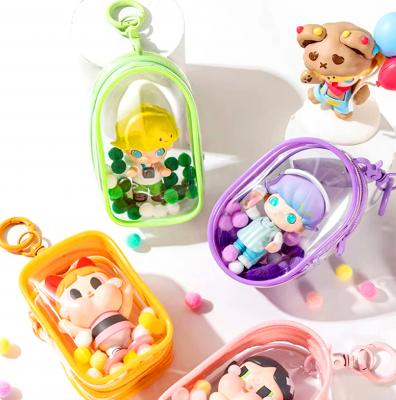Last week, vintage machinery at Yichang Rice Mill purred back to life following the completion of a restoration project to return the historic mill in Tainan’s Houbi District to its former glory. Located in the district’s Jingliao Village, the mill’s machinery, constructed from Taiwanese cypress, reaches two stories high and dates back 90 years.
Tainan City Government Cultural Affairs Bureau reached an agreement with trustees from the Liang family to open the mill to the public free of charge every Saturday and Sunday. Visitors to the mill will be able to learn all about rice and grain production and other aspects of rural life.
Constructed during the Japanese colonial era, Yichang Rice Mill was at the time largest rice mill in the area and the mill’s two story-high machinery, made from Taiwanese cypress, would have been an impressive sight. Rich in historical significance, the mill was designated a Historic Building by the Tainan City Government in 2010, and in 2016 a three-way agreement between the Ministry of Culture’s Bureau of Cultural Heritage, Tainan City Government and members of the Liang family secured NT$9.26 million to restore the mill, with the family carrying out the restoration work themselves.

Photos: Yang Chin-cheng, Liberty Times 照片:自由時報記者楊金城
Attending a ribbon cutting ceremony at Yichang Rice Mill, Tainan Mayor Huang Wei-che said the mill’s resurrection has created a vital living museum of local rice culture. Huang added that instead of being forced to listen to a teacher drone on about dry concepts in the classroom, schoolchildren can now visit the mill and easily visualize the process of rice production.
Representatives from the Liang family including first-generation miller Liang Lin Hsiu-peng, second-generation Liang Chih-kun and other family members were in attendance at the opening ceremony. Liang Chih-kun thanked the government for its assistance in restoring the mill and said his family hoped to preserve the cypress milling machinery, so that future generations will be able to see and touch a piece of local agricultural history.
(Translated by Edward Jones, Taipei Times)

Photos: Yang Chin-cheng, Liberty Times 照片:自由時報記者楊金城
台南市歷史建築、九十年歷史的後壁區菁寮里義昌碾米廠修復完成,上週歡喜「入厝」,高達兩層樓的檜木老碾米機重新啟動,再現風華。
台南市文化局和義昌碾米廠所有權人梁姓家族協議,碾米廠每週六、日免費開放參觀,現場介紹稻米、糧食及農村文化。
義昌碾米廠創立於日治時期,是當時後壁菁寮地區規模最大的碾米廠,兩層樓高的檜木碾米機具頗為壯觀,深具歷史價值,義昌碾米廠在二○一○年登錄為台南市歷史建築,二○一六年由文化部文化資產局、市府與所有權人梁家三方共同出資九百二十六萬元,由梁家自辦展開建物修復工程。

Photos: Yang Chin-cheng, Liberty Times 照片:自由時報記者楊金城
市長黃偉哲出席為義昌碾米廠揭牌時表示,義昌碾米廠能夠重生、活化,對稻米文化是非常重要的活見證、活歷史,老師在課堂上講得口沫橫飛,學童不一定聽得懂,倒不如帶學生實地參訪碾米廠,一看就懂。
義昌碾米廠第一代經營者梁林秀鵬、第二代梁志焜等家族人士也出席,梁志焜說,感謝政府協助修復碾米廠,家族把碾米廠、檜木製老碾米機保存下來,就是希望為後代子孫留下看得到、摸得到的農業文物。
(自由時報記者楊金城)

If you’ve recently spotted adults parading around with cuddly toys dangling from their designer handbags, your eyes haven’t been deceiving you. The playful trend of adorning bags with cute charms has become popular among people of various ages. Plushies like Labubu and anime and manga characters such as Chiikawa have become must-have accessories that make personal statements. The practice of attaching charms to personal items has been common across cultures throughout history. In ancient civilizations, charms were often used as symbols of protection, good luck, or identity. Fast-forward to more modern times, and style icons like Jane Birkin, a

A: Apart from Jin Yong, the late martial arts novelists Liang Yusheng and Gu Long were also very popular. B: Wasn’t Liang a pioneer of the “new school” wuxia genre in the 20th century? A: Yup, I really like his Tianshan mountain series. All the characters — such as the “White Haired Demoness” — are so vivid. B: The roles in Gu’s books are lively, too — like the “Fragrant Commander” Chu Liuxiang. A: And the TV drama adapted from the Chu Liuxiang series swept across Taiwan in the 1980s, with ratings surging over 70 percent at that time.

★ Bilingual Story is a fictionalized account. 雙語故事部分內容純屬虛構。 Kevin leaned over the bubbling pot. “Hey. . . are you okay? You’ve barely touched your food.” Zoey blinked. Her face was red — not from blushing, but from the “mala” spice and the heat of the room. Her blond hair clumped to her face like strands of fine spaghetti. Her carefully applied makeup now streaked. “This isn’t what I expected,” she said softly, forcing a smile. All around them, Kevin’s friends were laughing, shouting, and tossing ingredients into the broth. The air smelled of chili oil and garlic.

Continued from yesterday(延續自昨日) https://www.taipeitimes.com/News/lang If plushie charms are cute little nods to people’s interests, ita bags are full-on declarations. The term “ita” comes from the Japanese word itai, which means “painful” and reflects the overwhelming visual intensity of these bags. An ita bag is essentially a handbag, backpack, or tote meticulously decorated with an extensive collection of merchandise dedicated to a specific character or idol. These bags usually feature a clear plastic window to display carefully arranged pins, badges, keychains, or fan art. Both the interior and exterior may be covered in fandom memorabilia, creating an aesthetic so intense that it’s almost “painful”